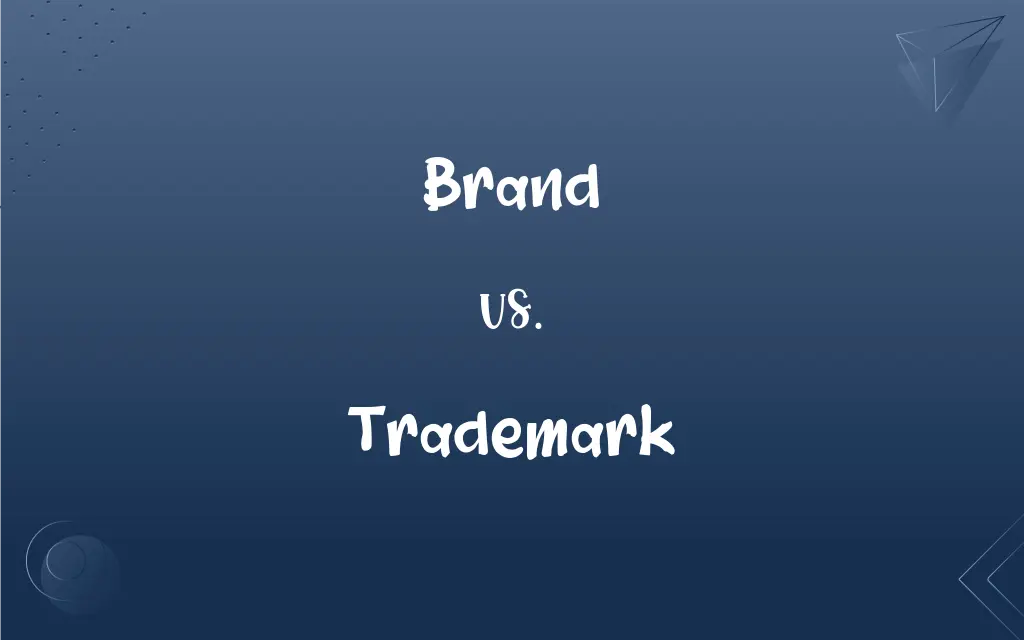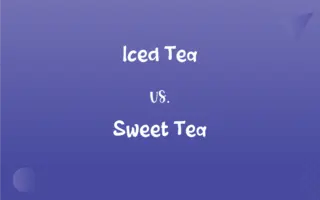Brand vs. Trademark: What's the Difference?
Edited by Harlon Moss || By Janet White || Published on December 7, 2023
Brand refers to the identity of a product or company, encompassing its name, design, and reputation. Trademark is a legal protection for brand elements like logos and names, preventing unauthorized use.

Key Differences
Brand is a marketing concept that represents the image and identity of a product, service, or company, often embodied in a name, symbol, or design. It is an intangible asset that helps in building customer loyalty and recognition. Trademark, on the other hand, is a legal instrument that grants the owner exclusive rights to use, license, or sell this brand identity. It legally protects the brand’s unique elements, ensuring they cannot be used without permission.
The brand of a company or product forms its personality and is developed through marketing strategies, customer experiences, and public perception. It's about how a company or product is perceived by consumers and the emotional connection they have with it. A trademark serves as a legal acknowledgment of this unique identity, safeguarding the brand’s distinctive symbols, phrases, or logos against infringement or misuse by others.
A brand encompasses the overall experience and image associated with a product or company, while a trademark specifically refers to the legal protection of the brand's unique features. The brand is developed through consistent marketing efforts and customer engagement, whereas a trademark is obtained through legal registration and is used to legally defend the brand's unique aspects.
Brand building involves creating a strong, positive perception of a company, its products or services in the customer’s mind by combining such elements as logo, design, mission statement, and a consistent theme throughout all marketing communications. Trademark protection, however, is more about the legal side of branding, focusing on securing the brand's uniqueness and ensuring that it is not exploited unlawfully.
The value of a brand is measured by customer recognition and the goodwill associated with it. This value can be significantly high for well-established brands. Trademark law plays a crucial role in protecting this value by preventing others from using similar identifiers that could confuse consumers or dilute the brand’s strength.
ADVERTISEMENT
Comparison Chart
Definition
An identity or image of a product or company, created through marketing and customer experience.
Legal protection of a brand's unique elements like logos, names, to prevent unauthorized use.
Purpose
To build customer loyalty and recognition, and differentiate from competitors.
To legally protect the brand’s identity and prevent misuse or infringement.
Nature
Intangible, involving emotional and perceptual aspects.
Legal and formal, requiring registration and legal procedures.
Development
Created through marketing strategies, customer interactions, and public perception.
Obtained through legal registration and maintained through legal enforcement.
Protection
Lacks legal protection in itself, vulnerable to imitation.
Offers legal defense against imitation or misuse of brand elements.
ADVERTISEMENT
Brand and Trademark Definitions
Brand
The perceived image and subsequent emotional response to a company, its products, or services.
Nike’s brand evokes a sense of athleticism and motivation.
Trademark
A symbol, word, or phrase legally registered or established by use as representing a company or product.
The golden arches are a registered trademark of McDonald’s.
Brand
A unique design, symbol, or name associated with a company or product that differentiates it in the market.
Apple’s brand is synonymous with innovation and quality in technology.
Trademark
A sign capable of distinguishing the goods or services produced or provided by one firm from those of other firms.
Twitter’s bird logo is a trademark identifying its social media service.
Brand
A representation of the experiences and reputation of a company or product.
Starbucks’ brand is not just about coffee, but about the experience of comfort and community.
Trademark
Legal protection that helps to identify and legally protect the goods or services of one entity from those of others.
The swoosh logo is a trademark of Nike, distinguishing their products.
Brand
A marketing tool that helps in identifying a product and distinguishing it from competitors.
The distinctive green and yellow of John Deere tractors are crucial elements of their brand.
Trademark
The exclusive right granted to a company or individual to use a specific mark to identify goods or services.
Adidas’ three stripes are a trademark that differentiates their apparel and footwear.
Brand
The collective impressions and associations held by consumers about a particular product or company.
Coca-Cola's brand is often associated with happiness and nostalgia.
Trademark
A form of intellectual property consisting of a recognizable sign, design, or expression.
The term ‘Google’ is a trademark for the company’s search engine services.
Brand
A trademark or distinctive name identifying a product, service, or organization.
Trademark
Abbr. TM A name, symbol, or other device used to identify and promote a product or service, especially an officially registered name or symbol that is thereby protected against use by others.
Brand
A product or service so identified
Bought a popular brand of soap.
Trademark
A distinctive characteristic by which a person or thing comes to be known
The snicker that became the comedian's trademark.
FAQs
What is a trademark?
A trademark is a legal designation that protects a brand's unique elements like its name and logo from unauthorized use.
How does one obtain a trademark?
A trademark is obtained by applying for registration with the appropriate legal authority, proving the uniqueness of your brand element.
What’s the role of branding in marketing?
Branding helps in creating a unique identity and emotional connection with customers, aiding in marketing efforts.
Is a trademark forever?
Trademarks can last indefinitely as long as they are used in commerce and renewed at the required intervals.
How is a brand developed?
A brand is developed through marketing, customer experience, and the overall perception of a company or product.
Can a slogan be a trademark?
Yes, a distinctive slogan can be trademarked if it uniquely identifies a company or product.
Can a color be trademarked?
Yes, distinctive colors used for branding can be trademarked in certain contexts.
What is a brand?
A brand is the distinctive identity that differentiates a product or company from its competitors, made up of elements like name, logo, and reputation.
Is branding only about logos and designs?
No, branding also includes customer experience, reputation, and the overall perception of a company or product.
Can a brand change over time?
Yes, a brand can evolve with changes in strategy, market trends, and customer preferences.
How important is a logo to a brand?
A logo is a crucial element of a brand, often serving as the most recognizable symbol of the company or product.
What are the benefits of having a trademark?
Trademarks provide legal protection, help in brand recognition, and prevent misuse or copying of brand elements.
Can a service be branded?
Yes, services, like products, can be branded to create a unique identity in the market.
Can any name be trademarked?
A name can be trademarked if it is distinctive and not already in use for similar goods or services.
How do trademarks affect consumer decisions?
Trademarks help in establishing trust and authenticity, influencing consumer choices.
Can a brand exist without a trademark?
Yes, a brand can exist without a trademark, but it lacks legal protection against infringement.
Can two companies have similar trademarks?
Similar trademarks can exist if they are in different industries or geographical areas and there's no risk of consumer confusion.
What happens if someone uses my trademark without permission?
Unauthorized use of a trademark can lead to legal action for infringement.
Is rebranding the same as changing a trademark?
Rebranding may involve changing a trademark, but it also encompasses broader changes in marketing and identity.
Does a trademark protect a brand worldwide?
Trademarks generally protect a brand in specific jurisdictions where they are registered.
About Author
Written by
Janet WhiteJanet White has been an esteemed writer and blogger for Difference Wiki. Holding a Master's degree in Science and Medical Journalism from the prestigious Boston University, she has consistently demonstrated her expertise and passion for her field. When she's not immersed in her work, Janet relishes her time exercising, delving into a good book, and cherishing moments with friends and family.
Edited by
Harlon MossHarlon is a seasoned quality moderator and accomplished content writer for Difference Wiki. An alumnus of the prestigious University of California, he earned his degree in Computer Science. Leveraging his academic background, Harlon brings a meticulous and informed perspective to his work, ensuring content accuracy and excellence.






































































